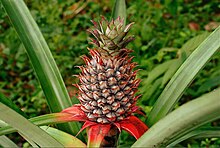
Back Ананас Abkhazian Pynappel Afrikaans Ananas ALS አናናስ Amharic Talacay AMI Ananas comosus AN Pīnæppel ANG أناناس Arabic اناناس (نوع من النباتات) ARZ Ananas comosus AST
| Pineapple | |
|---|---|

| |
| A pineapple on its parent plant | |
| Scientific classification | |
| Kingdom: | Plantae |
| Clade: | Tracheophytes |
| Clade: | Angiosperms |
| Clade: | Monocots |
| Clade: | Commelinids |
| Order: | Poales |
| Family: | Bromeliaceae |
| Genus: | Ananas |
| Species: | A. comosus
|
| Binomial name | |
| Ananas comosus | |
| Synonyms[1] | |
|
List
| |
The pineapple[2][3] (Ananas comosus) is a tropical plant with an edible fruit; it is the most economically significant plant in the family Bromeliaceae.[4]
The pineapple is indigenous to South America, where it has been cultivated for many centuries. The introduction of the pineapple plant to Europe in the 17th century made it a significant cultural icon of luxury. Since the 1820s, pineapple has been commercially grown in greenhouses and many tropical plantations.
Pineapples grow as a small shrub; the individual flowers of the unpollinated plant fuse to form a multiple fruit. The plant normally propagates from the offset produced at the top of the fruit[2][5] or from a side shoot, and typically matures within a year.[5][6]
- ^ "The Plant List: A Working List of All Plant Species". Archived from the original on 23 July 2021. Retrieved 25 July 2014.
- ^ a b Morton, Julia F (1987). "Pineapple, Ananas comosus". Retrieved 22 April 2011.
- ^ "Pineapple Definition | Definition of Pineapple at Dictionary.com". Dictionary.reference.com. Retrieved 6 December 2009.
- ^ Coppens d'Eeckenbrugge, G; Leal, F. (2003). "Chapter 2: Morphology, Anatomy, and Taxonomy". In Bartholomew, DP; Paull, RE; Rohrbach, KG (eds.). The Pineapple: Botany, Production, and Uses. Wallingford, UK: CABI Publishing. p. 21. ISBN 978-0-85199-503-8.
- ^ a b "How to grow a pineapple in your home". Pineapple Working Group-International Horticultural Society. Retrieved 15 August 2010.[permanent dead link]
- ^ "Pineapple Growing". Tropical Permaculture.com (Birgit Bradtke). Archived from the original on 17 June 2010. Retrieved 15 August 2010.